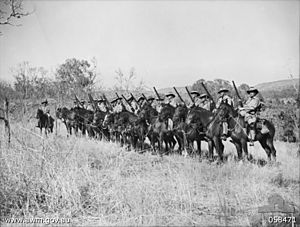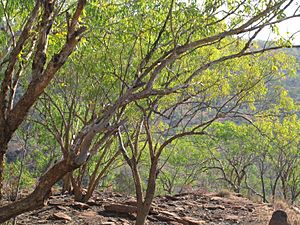2/1st North Australia Observer Unit facts for kids
The 2/1st North Australia Observer Unit (2/1 NAOU) was a special Australian Army group during World War II. It was formed in early 1942 in the Northern Territory. This unit used horses, like old-time cavalry, to patrol vast areas. Their main job was to give an early warning if Japanese forces were seen in northern Australia. At that time, many people thought Japan might try to invade Australia. As the danger of invasion lessened, the unit's work was reduced in 1943. It was finally closed down in early 1945. This unit is seen as an important early example for other scouting units in the Australian Army today.
The Nackeroos: Australia's WWII Horse Patrols
This special unit was officially formed on 11 May 1942. It was led by Lieutenant Colonel Bill Stanner. The unit's main base was set up in Katherine, Northern Territory. The soldiers in this unit were given the nickname "Nackeroos." They were formed when Japanese forces were moving quickly through the Pacific region. Places like Broome had recently been bombed, and there was a real fear that Australia could be invaded.
The Army was worried about the huge, empty coastlines and skies in northern Australia. This was especially true in the Kimberley area and the Northern Territory. So, the 2/1 NAOU was given the job of patrolling these distant places. They rode horses to look for any signs of Japanese activity. Their warnings would go to the Northern Territory Force, which was ready to defend the area.
Besides riding patrols, the Nackeroos also worked at fixed coast watch stations. These were places where they could keep an eye on the sea. They also did important signals work, sending messages. At its largest, the unit had about 550 people. This included 59 Aboriginal people who worked as guides and helpers. As the risk of Japanese landings went down, the Nackeroos' patrols were cut back in July 1943. The unit was officially closed in March 1945.
Lieutenant Colonel Stanner later explained how the unit worked. He said it was like a light horse regiment but very flexible. They had a job to scout and watch the coast. They were spread out across a huge area, from Cambridge Gulf to the Gulf of Carpentaria. The soldiers often worked in very small groups. They would be at observation posts or on patrols, watching over the edges of the Northern Territory Force's area.
What Happened Next? The Nackeroos' Legacy
Today, the Australian Army has units called Regional Force Surveillance Units. These groups do a job that is very much like what the 2/1 NAOU did. One of these modern units, NORFORCE, even traces its history back to the Nackeroos. They continue the important work of watching over Australia's remote northern areas.
See also
- Directorate of Research and Civil Affairs




